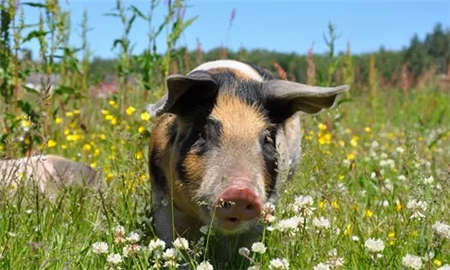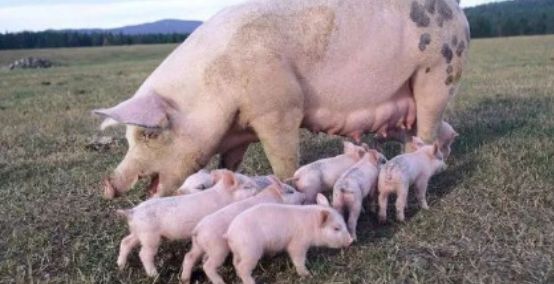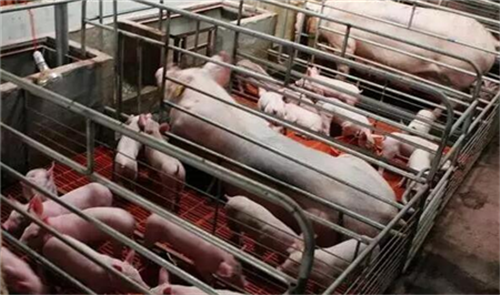How many methods are there for sows to breed?
The method of sow breeding can be either artificially assisted or artificially inseminated according to the actual situation. Most of the modern large-scale farms use artificial insemination. The operation methods of artificial insemination are as follows:
(1) semen collection method: first, train boars to climb across fake Taiwan pigs, at the beginning, apply sow urine or sow secretions on fake Taiwan pigs, and some smear boar semen, so as to induce boars to be in a state of excitement. While sniffing around the fake Taiwan pig, the boar turns around and temporarily climbs across the Taiwan pig to mate. When the boar begins to mate, the sperm collector should stand on the left (right) rear side of the fake Taiwan pig, hold the false vagina in the right hand and the head of the erectile penis in the left hand and insert it into the false vagina. After the penis is inserted into the false vagina, the front part of the penis is embedded by the false vaginal stenosis, and the first and second folds of the spiral part of the penis are forced to be pressed by the right pinkie finger, index finger and middle finger. The penis is elongated, and the left hand leaves from the false vagina to hold the collection bottle. The right hand continues to press the front end of the penis as it is. Hand pressure should not be too large, to control the boar penis from the false vagina slippage is limited, and with a loose rhythm to stimulate ejaculation. When the boar is fully excited and the glans bounce frequently, it means that they are going to ejaculate. Do not let go during ejaculation, otherwise the reduction of pressure will lead to interruption of ejaculation.
For young boars without artificial insemination training, sows with or without oestrus can be protected and boars can be allowed to climb. Semen was collected with fake vagina for 2 ~ 3 times, and then trained with fake Taiwan pigs. After the boar ejaculates, collect the semen well in the 300-500 ml jar, and pay attention to keep the jar clean and sterilized. When the temperature changed sharply, the sperm motility decreased significantly. Therefore, in the cold season when the temperature drops below 15 °C, the semen bottle is placed in a container containing warm water of about 38 °C to prevent the semen temperature from continuing to drop.
(2) ejaculation state: the average ejaculation time was 60.7 minutes, the shortest was 2 minutes, and the longest was 23 minutes. Ejaculation begins with almost colorless fluid with a small amount of urine, followed by thick semen, or real semen. Semen is composed of liquid and gelatin. most of the thicker semen is ejaculated in the first half of ejaculation, and then tends to decrease gradually. The sperm count is the highest in the semen within 2 minutes after the start of ejaculation, accounting for an average of 82% of the total sperm count. The peculiar gelatinous substance in pig semen is secreted by the urethral bulbar gland and is excreted during ejaculation. The total number of colloidal substances excreted in one ejaculation was 3821833, with an average of 909.
(3) semen preservation: immediately after semen collection, the gel is filtered with clean gauze and the original semen is preserved. The preserved semen was put into a pre-sterilized thin-mouth bottle with a plug, and then hoisted into a 15-20 °C thermos flask. When collecting semen in the warm season, if you inseminate on the same day, you don't have to do special heat preservation treatment. When it is not easy to find ice in summer, it can be hoisted into an appropriate well or stored in a cold place. When preserving semen, the temperature should try to drop slowly and avoid sudden changes. The suitable temperature for semen preservation is 15 °20 °C. at this temperature, sperm can generally survive for 5 ~ 7 days and have insemination activity within two days. Semen preservation should also avoid direct sunlight, take and put should be careful not to mix with water, to prevent oscillation in transportation. After semen collection, in the case of insemination on the same day, semen is generally inseminated with the original liquid. If dilution is needed, 5%-6% glucose solution, 10% sucrose solution or 0.9% saline is usually used. Semen should be diluted before use and should not be preserved after dilution.
After semen collection, the sperm layer and semen layer will be separated for a period of time, and the sperm will be in a state of false death for a few hours, and the original motility state can usually be restored 2 hours after the temperature 38 °C oscillation, but the sperm motility must be examined by microscope. Insemination after rejuvenation will not affect conception.

(4) insemination method: first wash the injector (vas deferens) and inhale semen, top up, discharge the air, the injector is full of semen, there is no gap. If the sow is in estrus at the right time, but does not have a good Baoding, when the operation of the sow is affected by the sow activity, it is necessary to inseminate the tip of the nose and scrub the vulva of the sow before insemination.
When injecting people, first open the labia with the left hand and insert the injector directly into the vagina with the right hand. When inserting 15cm to 20cm, insert the top of the injector slightly upward to prevent the front end of the glass tube from piercing the external orifice of the urethra. Then, restore the injector to the horizontal direction and insert it while turning gently. When inserting 25cm to 30cm, there is resistance at the top of the injector. At this time, further left and right movement and push the injector, the front end of the small glass tube into the uterine fold, that is to obtain sensitivity.
At this time, it can be considered that the two hard wrinkles have been reached, and then connect the syringe containing semen, and slowly inject semen. When the front end of the injector is blocked by mucous membrane, the semen can be reversed, and then the injector rotates left and right, try to change the position slightly, and then all the semen can be input. In addition, the injector in the pig cervix sensation is not obvious, as long as the injected semen does not flow out, generally insemination can be successful.
(5) semen infusion and conception rate: in order to achieve conception, a sufficient amount of semen must be injected. Usually about 50 ml, in a short preservation time (within 24 hours), a large number of sperm, the use of 30 ml can also achieve good results. The number of semen preserved within 24 hours was about 5 billion, and more than 24 hours about 7 billion had a good conception rate. The sperm motility should be more than 70 points and the semen dilution ratio should be 2-3 times. The suitable period for insemination of pigs is 10-26 hours after the boar is allowed to climb. Compared with natural mating, there was no significant difference in conception rate between artificial insemination and natural mating when semen was preserved within 24 hours. However, under normal circumstances, it is not always better than natural mating, so it is necessary to improve the technical level, if skilled, the conception rate can reach more than 90%.
(6) Preservation and utilization of frozen semen: to carry out artificial insemination, the ideal semen should be semen with high sperm concentration, vitality, high survival rate and conception rate. Frozen pig semen in liquid nitrogen at-196 °C, the survival rate and motility of semen preserved for 500 to 600 days were almost unchanged, and the semen preserved for 154 days could be conceived.
Frozen semen has the following advantages:
① can improve the utilization efficiency of superior breeds of boars.
② can easily preserve semen for a long time, long-distance transportation and international semen communication.
③ can adjust the estrus of sows and can be effectively applied to the adjustment of piglet production.
It is possible for ④ to establish a sperm bank.
(7) semen diluent: semen diluent can prevent the change of temperature and pH value, increase semen volume, provide nutrition for sperm and inhibit bacterial growth. Most diluents are made up of glucose, electrolytes, buffers and antibiotics.
There are many preparation methods of pig semen diluent, and its formulations are as follows:
a. Milk powder diluent: 9 grams of milk powder, 100 ml of distilled water.
b. Lime diluent: 5 grams of glucose, 0.5 grams of sodium citrate, 100 ml of distilled water.
c. "Kafu" diluent: glucose 6g, sodium citrate 0.35g, sodium bicarbonate 0.12g, sodium ethylenediamine tetraacetate 0.37g, penicillin 30000 international units, streptomycin 100000 international units, distilled water 100ml.
d. Ammonia egg liquid: 3 grams of aminoacetic acid, 100 milliliters of distilled water, composed of basic liquid, 70 milliliters of basic liquid plus yolk 30 milliliters.
e. Lime B liquid: glucose 5 grams, sodium citrate 0.3 grams, ethylenediamine tetraacetic acid 0.1 grams, distilled water 100 ml.
f. Lime carbon egg liquid: glucose 5.1 g, sodium citrate 0.18 g, sodium bicarbonate 0.05 g, ethylenediamine tetraacetic acid 0.16 g, distilled water 100 ml, basic liquid 97 ml plus yolk 3 ml.
In addition to "Kafu", the dosage of antibiotics is 1000 international units per milliliter of penicillin and 1000 micrograms of streptomycin.
The preparation of three kinds of diluents commonly used abroad:
A.BL-1 solution (USA): glucose 2.9%, sodium citrate 1%, sodium bicarbonate 0.2%, potassium chloride 0.03%, penicillin 1000 international units / ml, dihydrostreptomycin 0.01%.
B.IVT solution (UK): 0.3g of glucose, 2g of sodium citrate, 0.21g of sodium bicarbonate, 0.04g of potassium chloride, 0.3g of aminobenzenesulfonic acid, 100ml of distilled water, heated to make it fully dissolved, after cooling for about 20 minutes, so that the pH value reached 6.5.
c. Milk powder-glucose solution (Japan): 3.0 grams of skim milk powder, 9 grams of glucose, 0.24 grams of sodium bicarbonate, 0.2 grams of a-amino-p-toluenesulfonamide hydrochloride, 0.4 grams of sodium sulfadiazine, 200 ml of sterilized distilled water.
- Prev

Piglets don't eat ingredients? What should be paid attention to in the early feeding and food inducement?
Piglets don't eat ingredients? What should be paid attention to in the early feeding and food inducement?
- Next

Guide to how to breed pigs and how to manage them (serial 11)
Guide to how to breed pigs and how to manage them (serial 11)
Related
- On the eggshell is a badge full of pride. British Poultry Egg Market and Consumer observation
- British study: 72% of Britons are willing to buy native eggs raised by insects
- Guidelines for friendly egg production revised the increase of space in chicken sheds can not be forced to change feathers and lay eggs.
- Risk of delay in customs clearance Australia suspends lobster exports to China
- Pig semen-the Vector of virus Transmission (4)
- Pig semen-the Vector of virus Transmission (3)
- Five common causes of difficult control of classical swine fever in clinic and their countermeasures
- Foot-and-mouth disease is the most effective way to prevent it!
- PED is the number one killer of piglets and has to be guarded against in autumn and winter.
- What is "yellow fat pig"? Have you ever heard the pig collector talk about "yellow fat pig"?

